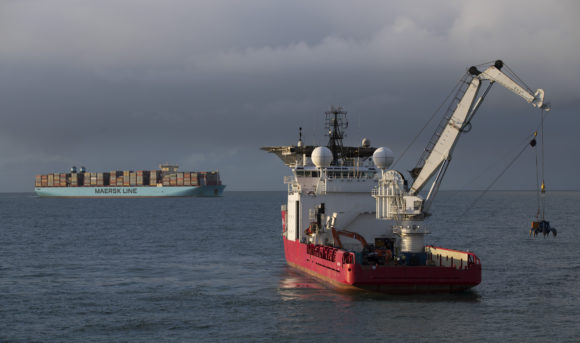By Mike Corder | June 29, 2020 INSURANCE JOURNAL

A Dutch safety watchdog said Thursday [June 25] that it is “undesirable” for large container ships to use a shipping route through an environmentally sensitive, shallow sea off the coast of the Netherlands, Germany and Denmark in heavy northwesterly storms because of the heightened risk of them losing their cargo.
The conclusion came in a report by the Dutch Safety Board into the loss of hundreds of containers from a ship, the MSC Zoe, on New Year’s Day 2019, that led to tons of cargo washing up on nearby beaches.
“The lessons to be learned from this accident must result in a better risk management of container transport on the shipping routes,” the report said.
The ship, carrying more than 8,000 containers, was sailing north of a chain of islands in the Wadden Sea on a route from the Portuguese port of Sines to Bremerhaven, Germany, when it was battered by waves kicked up by a northwesterly storm. It lost 342 containers and 3,000 tons of cargo overboard, the Safety Board report said.
There are two shipping routes north of the Wadden Islands – a southern passage, which is shallower and closer to the islands, and a northern route. The Zoe was using the southern route.
“The Dutch Safety Board concludes that due to the value of the Wadden area, it is undesirable that these container ships choose the southern shipping route past the Wadden coast during a northwestern storm,” the board said.
In the days and weeks after the incident, debris including shoes, televisions, lightbulbs and packaging material washed up on normally pristine beaches. The Dutch government sent the armed forces to the region to help in the cleanup operation and a salvage ship fished sunken containers from the seabed.
When slammed from the side by waves kicked up by northwesterly storms in the Wadden Sea, “large, wide container ships make extreme rolling movements,” the board said in a statement. It added that on the shallow southern shipping route there is a risk of ships grounding and waves forced upward putting extreme stress on lashing systems used to hold containers on board.
The safety board made a series of recommendations, including that the governments of the Netherlands, Germany and Denmark work together to make a proposal to the International Maritime Organization to safeguard the environmentally sensitive Wadden area.
“The aim of this proposal should be to minimize the loss of containers north of the Wadden Islands and to protect the Wadden area,” the Dutch report said. “This may include measures for (a specific category of) container ships, and if necessary alteration of the two shipping routes north of the Wadden Islands.”
Bernd-Carsten Hiebing, a lawmaker for German Chancellor Angela Merkel’s center-right party in the state of Lower Saxony, said the report highlighted the continued dangers of shipping. But he pushed back against calls by the opposition Green party for a ban on `mega container ships,’ saying it wouldn’t help improve security for people and the environment.
Instead, he said it would be better to consider more closely which routes are navigable by which types and classes of ships. He also backed stricter rules for securing freight and the use of location transmitters for hazardous cargo containers.
____
AP writer Frank Jordans in Berlin contributed to this report.
Photograph: The Geosund salvaging ship lifts a container from the seabed off the northwestern coast of the Netherlands on Monday, Jan. 21, 2019. Dutch authorities say a freight ship lost dozens more containers than previously thought when it was caught in a heavy storm on Jan. 2 when at least 345 containers fell off the MSC Zoe. Photo credit: AP Photo/Peter Dejong.
Related:
Dutch Authorities Raise Number of MSC’s Containers Lost in North Sea Storm
Copyright 2020 Associated Press. All rights reserved. This material may not be published, broadcast, rewritten or
No comments:
Post a Comment